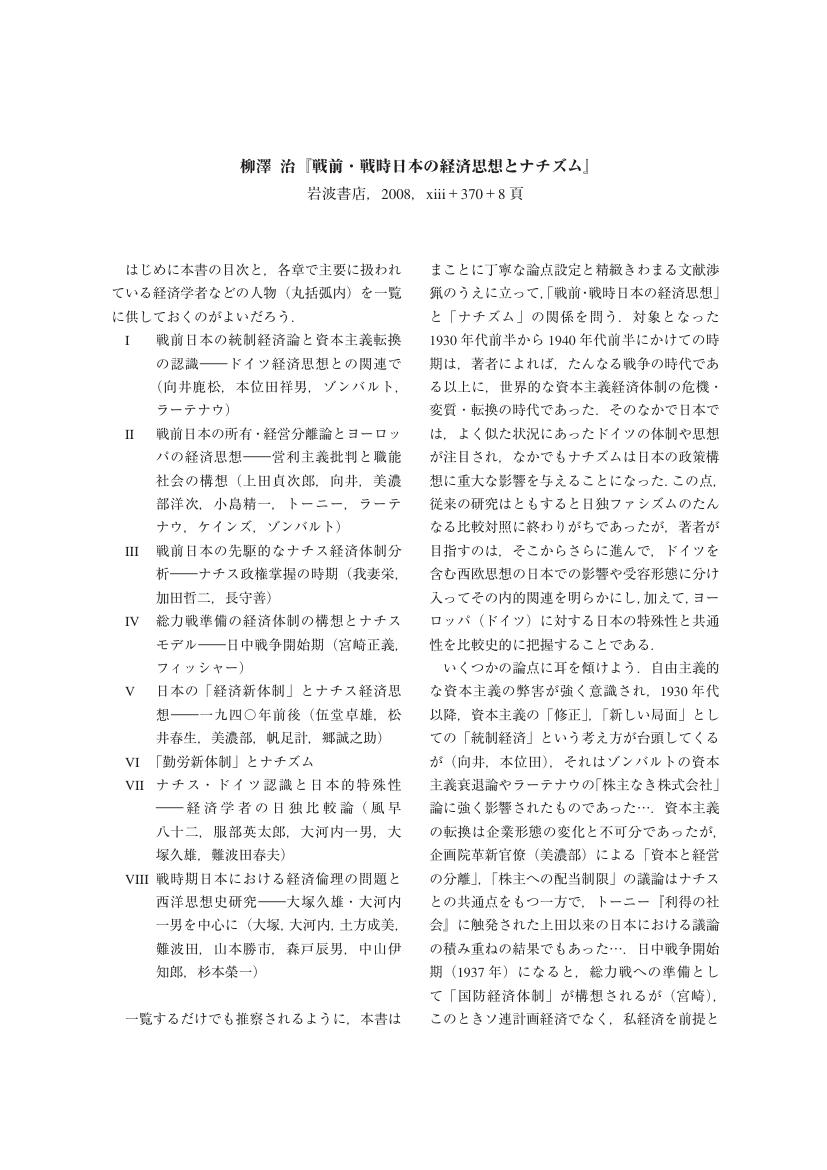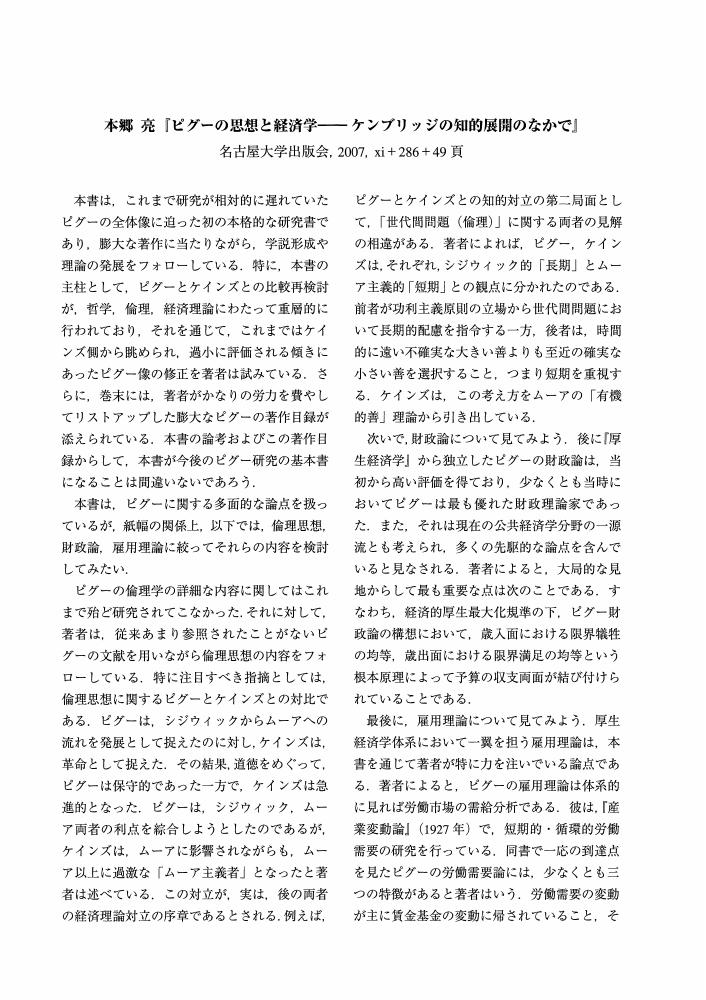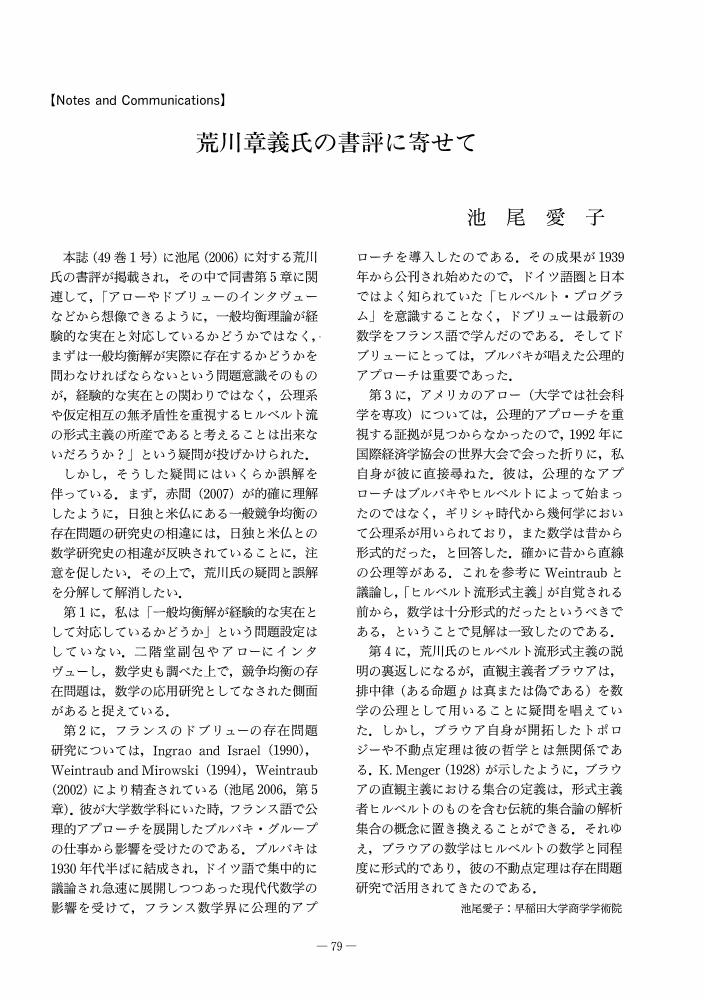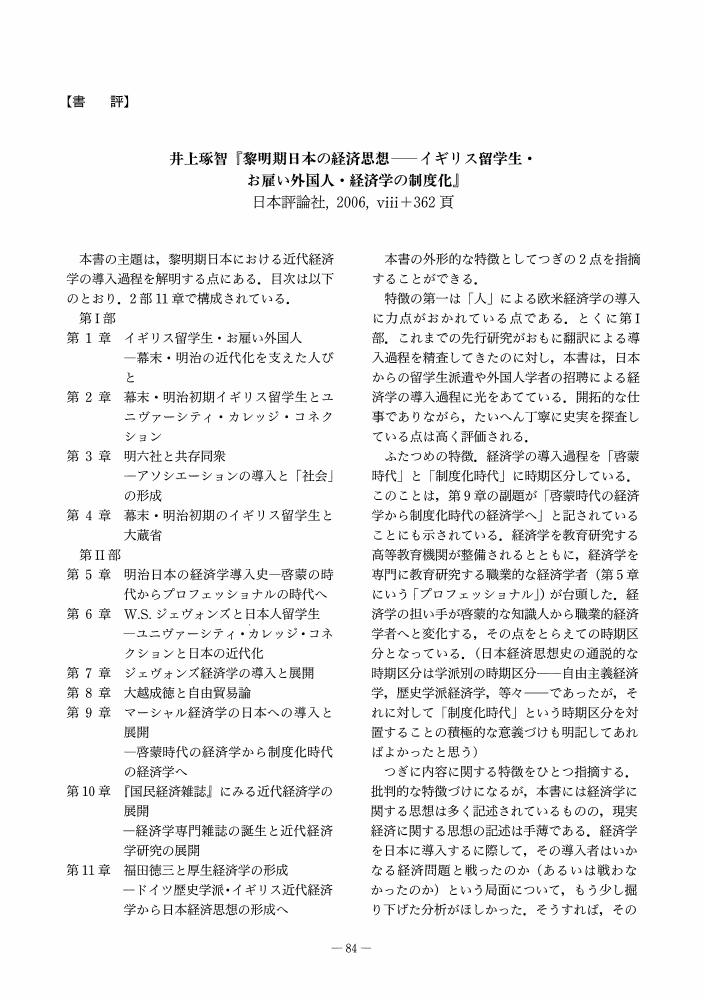- 著者
- 山田 鋭夫
- 出版者
- 経済学史学会
- 雑誌
- 経済学史研究 (ISSN:18803164)
- 巻号頁・発行日
- vol.51, no.1, pp.119-120, 2009 (Released:2019-06-22)
- 著者
- 大友 敏明
- 出版者
- 経済学史学会
- 雑誌
- 経済学史研究 (ISSN:18803164)
- 巻号頁・発行日
- vol.51, no.1, pp.36-59, 2009 (Released:2019-06-21)
- 参考文献数
- 40
1 0 0 0 OA F. ラヴィントンにおける企業家の役割 理論構築,現状認識,および規範的な行動基準
- 著者
- 小峯 敦
- 出版者
- 経済学史学会
- 雑誌
- 経済学史研究 (ISSN:18803164)
- 巻号頁・発行日
- vol.51, no.1, pp.60-75, 2009 (Released:2019-06-21)
- 参考文献数
- 50
Frederic Lavington (1881–1927) played a significant role as a node between Marshall’s and Keynes’s eras. While Marshall trusted on the individual chivalrous entrepreneur, Keynes no longer depended on such an individual and placed his hopes on semi-autonomous bodies guided by public authorities. Although Lavington was a devotedly orthodox Marshallian, he was also a revolutionary theory developer, and he was located in the transition period between the two important figures. He recognised an inherent instability in the modern economies of the time but still held an optimistic view of capitalism. Lavington relied on able entrepreneurs as a group, who he believed could eliminate the contradictions between individual rational calculations and collective disturbing consequences. Lavington’s insight on capitalism can be understood as a threefold-layer structure, at the core of which is an entrepreneur. This structure comprises the following: (1) theory construction, related to revolutionary devices such as liquidity preference and portfolio selection, (2) contemporary recognition, related to the trade cycle and (3) normative behavour, related to leaders in industry. The first is concerned with rational behaviour under uncertainty; the second, with unexpected disturbances and the third, with a coordination problem: if the captains of industry work well in business organizations, the gap between the micro- and macro-layers tends to reduce. Although he was very close to Keynes in the light of points (1) and (2), Lavington shared almost the same view of Marshall in the light of point (3). This duality had made evaluations on him extremely difficult. JEL Classification: B10, B31, L16
- 著者
- 岡田 元浩
- 出版者
- 経済学史学会
- 雑誌
- 経済学史研究 (ISSN:18803164)
- 巻号頁・発行日
- vol.51, no.1, pp.93-95, 2009 (Released:2019-06-22)
- 著者
- 八木 紀一郎
- 出版者
- 経済学史学会
- 雑誌
- 経済学史研究 (ISSN:18803164)
- 巻号頁・発行日
- vol.51, no.1, pp.101-102, 2009 (Released:2019-06-22)
- 著者
- 青木 裕子
- 出版者
- 経済学史学会
- 雑誌
- 経済学史研究 (ISSN:18803164)
- 巻号頁・発行日
- vol.51, no.1, pp.103-106, 2009 (Released:2019-06-22)
- 被引用文献数
- 1
- 著者
- 河野 良太
- 出版者
- 経済学史学会
- 雑誌
- 経済学史研究 (ISSN:18803164)
- 巻号頁・発行日
- vol.50, no.2, pp.103-104, 2009-02-05 (Released:2010-08-05)
1 0 0 0 OA 西沢保『マーシャルと歴史学派の経済思想』岩波書店, 2007, xvi+646頁
- 著者
- 佐々木 憲介
- 出版者
- 経済学史学会
- 雑誌
- 経済学史研究 (ISSN:18803164)
- 巻号頁・発行日
- vol.50, no.2, pp.105-106, 2009-02-05 (Released:2010-08-05)
- 著者
- 山崎 聡
- 出版者
- 経済学史学会
- 雑誌
- 経済学史研究 (ISSN:18803164)
- 巻号頁・発行日
- vol.50, no.2, pp.109-110, 2009-02-05 (Released:2010-08-05)
- 著者
- 菊池 壮蔵
- 出版者
- 経済学史学会
- 雑誌
- 経済学史研究 (ISSN:18803164)
- 巻号頁・発行日
- vol.50, no.2, pp.111-112, 2009-02-05 (Released:2010-08-05)
1 0 0 0 OA 斧田好雄『マーシャル国際経済学』晃洋書房, 2006, iv+224頁
- 著者
- 藤本 正富
- 出版者
- 経済学史学会
- 雑誌
- 経済学史研究 (ISSN:18803164)
- 巻号頁・発行日
- vol.50, no.1, pp.115-116, 2008-07-31 (Released:2010-08-05)
- 著者
- 秋田 清
- 出版者
- 経済学史学会
- 雑誌
- 経済学史研究 (ISSN:18803164)
- 巻号頁・発行日
- vol.50, no.1, pp.117-118, 2008-07-31 (Released:2010-08-05)
- 著者
- 江里口 拓
- 出版者
- 経済学史学会
- 雑誌
- 経済学史研究 (ISSN:18803164)
- 巻号頁・発行日
- vol.50, no.1, pp.119-120, 2008-07-31 (Released:2010-08-05)
- 著者
- 水田 健
- 出版者
- 経済学史学会
- 雑誌
- 経済学史研究 (ISSN:18803164)
- 巻号頁・発行日
- vol.50, no.1, pp.121-123, 2008-07-31 (Released:2010-08-05)
1 0 0 0 OA 平井俊顕『ケインズとケンブリッジ的世界』ミネルヴァ書房, 2007, xi+401頁
- 著者
- 中矢 俊博
- 出版者
- 経済学史学会
- 雑誌
- 経済学史研究 (ISSN:18803164)
- 巻号頁・発行日
- vol.50, no.1, pp.124-125, 2008-07-31 (Released:2010-08-05)
- 著者
- 岩本 吉弘
- 出版者
- 経済学史学会
- 雑誌
- 経済学史研究 (ISSN:18803164)
- 巻号頁・発行日
- vol.50, no.1, pp.111-112, 2008-07-31 (Released:2010-08-05)
1 0 0 0 OA 荒川章義氏の書評に寄せて
- 著者
- 池尾 愛子
- 出版者
- 経済学史学会
- 雑誌
- 経済学史研究 (ISSN:18803164)
- 巻号頁・発行日
- vol.49, no.2, pp.79-80, 2007-12-25 (Released:2010-08-05)
- 参考文献数
- 6
- 著者
- 伊藤 誠一郎
- 出版者
- 経済学史学会
- 雑誌
- 経済学史研究 (ISSN:18803164)
- 巻号頁・発行日
- vol.49, no.2, pp.82-83, 2007-12-25 (Released:2010-08-05)
- 著者
- 藤井 隆至
- 出版者
- 経済学史学会
- 雑誌
- 経済学史研究 (ISSN:18803164)
- 巻号頁・発行日
- vol.49, no.2, pp.84-85, 2007-12-25 (Released:2010-08-05)
- 著者
- 姫野 順一
- 出版者
- 経済学史学会
- 雑誌
- 経済学史研究 (ISSN:18803164)
- 巻号頁・発行日
- vol.49, no.2, pp.86-87, 2007-12-25 (Released:2010-08-05)


















